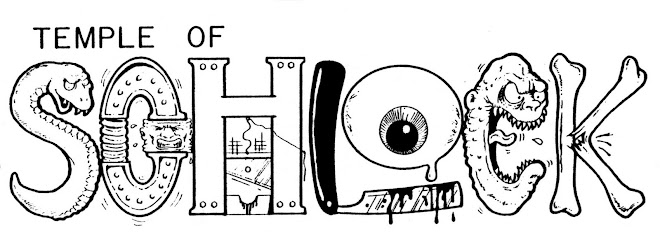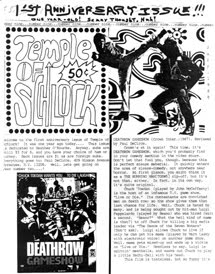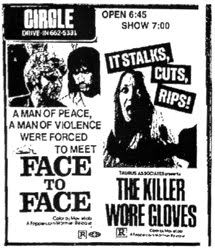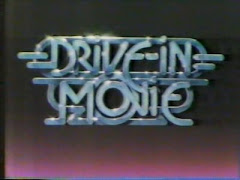Sunday, December 29, 2013
Movie Ad of the Week: THE HALLUCINATORS (1971)
William Grefé's THE NAKED ZOO (1970) -- filmed under the title THE GROVE and starring Rita Hayworth, Stephen Oliver, and Fay Spain -- opened in Lima, OH on May 12, 1971 as THE HALLUCINATORS. The tag line "See it the way it isn't" seems especially fitting since this is the Barry Mahon revision of Grefé's film, featuring nudie footage and an appearance by blues rockers Canned Heat. Both versions will be issued on a DVD/Blu-ray combo in 2014 by Vinegar Syndrome.
Sunday, December 22, 2013
Movie Ad of the Week: GRASSLAND / HEX (1973)
GRASSLAND (1973), a.k.a. HEX, is a supernatural biker-horror movie set in Nebraska in 1919, starring Keith Carradine, Scott Glenn, Hilary Thompson, Cristina Raines, Gary Busey, Robert Walker, Jr. and Dan Haggerty. Directed and co-written by Leo Garen, from a story by Dorian William Cannon and Vernon Zimmerman, GRASSLAND was shot in 1971 and barely released under two different titles by a thoroughly confused 20th Century Fox in 1973. Prism Entertainment released it on VHS as THE SHRIEKING in 1991, and 15 years later it resurfaced on DVD as CHARMS.
Monday, December 09, 2013
Mystery Movie: KUNG FU KIDS (ca. 1973)
Big thanks to Fred Adelman of Critical Condition for bringing this one to our attention: a Taiwanese (?) fantasy film released in the U.S. as a kiddie matinee during the height of the '70s kung fu craze. The ad mat above and the one-sheet below are all we have to go on. Killer bats, giant cats, man-eating plants, a two-headed dragon... With all that goodness packed into one movie, it's incredible that KUNG FU KIDS has flown below the radar for so long. Anyone know what this is, and where the heck we can find a copy?
UPDATE: We found out recently that KUNG FU KIDS was distributed by Aquarius Releasing, and also played kiddie matinees as SUPERBOY AND SUPERGIRL AGAINST THE 7 MONSTERS. The ad below is from a booking in Westfield, NJ during the weekend of October 19-21, 1973.
Labels:
AQUARIUS RELEASING,
MYSTERY MOVIES,
TERRY LEVENE
Sunday, December 08, 2013
Movie Ad of the Week: MASTER OF HORROR w/ MASTER OF TERROR (1966)
Presented by Jack H. Harris and released by Joe Solomon's U.S. Films, these "two chillers to turn your dreams into screams" arrived in Houston, TX on March 3, 1966. MASTER OF HORROR is the truncated U.S. version of OBRAS MAESTRAS DEL TERROR (1960), an Argentinian film consisting of adaptations of two Edgar Allan Poe tales, "The Facts in the Case of M. Valdemar" and "The Cask of Amontillado." A third story, "The Tell-Tale Heart," was cut from this version, but later turned up in LEGEND OF HORROR (1972). The co-feature, MASTER OF TERROR, is a reissue of the Jack H. Harris production 4D MAN (1959), originally released by Universal and starring Robert Lansing, Lee Meriwether, James Congdon, Robert Strauss and Patti Duke.
Labels:
JACK H. HARRIS,
JOE SOLOMON,
MOVIE AD OF THE WEEK
Monday, December 02, 2013
TARGET SMUT: In Search of a Lost Anti-Porn Classic
Target Smut:
In Search of a Lost Anti-Porn Classic
by
Whitney Strub
TARGET SMUT may have had more direct impact than any anti-porn film in history — admittedly, not a momentous claim when one considers the rather inglorious canon that would include such entries as the feminist polemic NOT A LOVE STORY or this year's DON JON — yet it remains one of the most obscure. Produced by Citizens for Decent Literature in 1968 to attack the Supreme Court, it served its purpose with gusto, then disappeared immediately, still a lost work today.
Citizens for Decent Literature (CDL) was the preeminent anti-smut organization of the 1960s, nestled snugly between earlier Catholic pressure groups and later Christian Right ones. Less widely acknowledged, it was also without question the dominant producer and distributor of anti-porn films in that era, one of which, PERVERSION FOR PROFIT, might be the most famous title in the genre.
Founded by Cincinnati lawyer Charles Keating in the late 1950s, CDL amassed a rapid national following and exerted a powerful influence by the late Sixties, reaching its peak when President Richard Nixon appointed Keating to the President’s Commission on Obscenity and Pornography. Later Keating let CDL languish as he shifted his interests toward junk bonds in the 1980s, contributing to our current era of disaster capitalism during the Savings & Loan catastrophes of the Reagan era. Apparently sexual decency meant more to him than the financial sort.
I spent a good portion of my twenties obsessively pursuing CDL through archives across America. From right-wing literature collections in Los Angeles and Kansas, to fragmentary records from local chapters in Arizona and Pennsylvania, to the Lyndon Johnson Presidential Library and Museum in Austin, I chased every lead I could identify. It was the nerd version of detective work, and ultimately, I titled my first book, Perversion for Profit: The Politics of Pornography and the Rise of the New Right, after CDL’s film.
The group occupies a central role in my narrative of modern conservatism, and in my favorite chapter I show how they successfully modernized pro-censorship positions for an American public that didn’t want to see itself as Victorian or prudish — but also disliked the increasingly graphic sexual content of books, films, and magazines from the late Fifties onward.
As hard as I tried to look under every stone and follow the scattered CDL paper trail to its bitter end, you always miss something. Just this summer, digging through a collection at the National Archives in Washington, DC, I stumbled upon a file that seemed slightly out of place. The collection I was investigating was the records of the Senate Judiciary Subcommittee to Investigate Juvenile Delinquency, mostly dated 1953-61 — but inside was a folder from 1968, with a transcript for TARGET SMUT.
With this, we can partially reconstruct TARGET SMUT — though some background might help.
As Keating built CDL into an empire, he smartly recognized the importance of controlling cultural narratives. It was the age of Marshall McLuhan, and not just lefties like Castro and Godard were thinking critically about the powers of the mass media. From early on, CDL turned not just toward repressing sexual expression, but also toward producing it, in the form of a series of short anti-porn films that tended to wallow in sensationalism.
PERVERSION FOR PROFIT is surely the most famous of CDL’s films, partly due to its internet ubiquity. We laugh today at its campy scare tactics, but the film was taken seriously in its day, paralleling the rhetoric coming from national authorities like J. Edgar Hoover. Serious debates were held over the film’s merits, as in this fascinating St. Louis episode:
Another early CDL film, PAGES OF DEATH, is lost, to the best of my knowledge. Jim Lindeman at Vintage Sleaze recently ran a great piece on it, and here’s an ad for what I believe was its world premiere, in Cincinnati, 1962:
A third CDL film, PRINTED POISON, popped up on the second disc of the HEAVY PETTING DVD several years ago; like PERVERSION, it wallows in the very muck it claims to fight, charting the course of a district attorney’s awakening to the need for smut-busting.
This trilogy constituted the core cinematic canon of CDL into the late 1960s, as seen in this mailing (archived at the University of Kansas’s Wilcox Collection in 1969, but circulating in the years beforehand):
Which takes us to TARGET SMUT. By 1968, the Supreme Court under Chief Justice Earl Warren had spent a solid decade liberalizing obscenity law, until the boundaries of the legally acceptable had shifted from Lady Chatterley to “split-beaver” shorts and, soon, hardcore. Nothing better symbolized to CDL the moral rot at the heart of the so-called sexual revolution. Keating and CDL filed briefs in numerous Supreme Court obscenity cases, and they generally went disregarded, adding insult to perceived injury. So when President Lyndon Johnson nominated Abe Fortas to replace the retiring Earl Warren as Chief Justice, CDL geared up for revenge. Fortas, already a sitting justice on the High Court, was among its more liberal members, and for a growing portion of the conservative public, “liberal” meant “libertine.”
Conservative attacks on Fortas had begun immediately in early 1968, but gained little public traction. South Carolina senator Strom Thurmond, one of the reactionary leaders of the anti-Fortas cadre, vilified him constantly, on a variety of grounds: he had communist ties, he was soft on crime, the appointment was sheer LBJ cronyism (on this last point, he was correct). None of it seemed to stick — until Keating and CDL lawyer James Clancy offered a new line of attack: Fortas, who had once filed a brief on behalf of Playboy, was singlehandedly responsible for the porn-driven moral decline of America.
TARGET SMUT was apparently cobbled together as a visual indictment of Fortas and the Court. The filmstrip itself, unfortunately, has yet to surface, but the transcript at the National Archives survives; while it doesn’t provide a direct sense of the visuals, it offers strong hints. The narration details the legal history of obscenity, tracing it back to the 1688 English case of “rebel playwright” Sir Charles Sedley, who exposed himself on a balcony in the hopes of “bringing about a change in the social mores.” “Today,” it warns, “we have ‘rebels’ in the same and other professions, who entertain the same ideas.”
From there, things jump to the 1957 Supreme Court case Roth v. U.S., in which the Court established modern American obscenity doctrine. Linking Roth back to Sedley’s case is “our Judeo-Christian culture and the Common Law of our Anglo-Saxon heritage,” CDL explains. The research and facts are generally solid, but the ideological spin is heavy-handed; central to CDL’s legal argument is that power should reside with juries but has been usurped by appellate judges—an analysis that seems blithely oblivious to the entire course of American legal history since the Civil War. Because Justices Hugo Black and William O. Douglas refuse to recognize the validity of obscenity charges, TARGET SMUT contends, their votes should be “disqualified as not in consonance with the law”—a deliberate misunderstanding of the constitutional interpretation that is the High Court’s very function.
TARGET SMUT points to Abe Fortas as a significant part of the problem, and touts CDL’s own role in challenging such decadent judicial politics, recounting in heroic terms the 1966 Court term, in which “expectations were high,” as CDL counsel “climbed the 42 marble steps of the United States Supreme Court building.” Instead, a devastating setback occurred as the Court sat on over two dozen cases until 1967 before summarily reversing virtually every obscenity conviction that had reached it. “The root of this Nation’s problem,” the narrator argues, “is the United States Supreme Court and the extra-judicial judgments of some of its membership.”
Sprinkled throughout this dry legal discussion are plentiful descriptions of the texts at play in the cases, and it is near-certain that TARGET SMUT made ample visual use of them, much as the other CDL films had done. Images of the Court building and carefully chosen low-angle frown shots of Fortas or Douglas can only maintain viewer attention so long, after all; more captivating are such titles as Bondage Boarding School, Travelling Saleslady Gets Spanked, Lust Hungry, and Flesh Avenger. We are offered graphic descriptions of the textual and visual content of books and magazines. In one example, “The buttocks of many are elevated and thrust toward the camera, as if in invitation to sexual intercourse or sodomy. Lesbianism and group orgies are suggested by group shots of naked females in physical contact.” This was no doubt driven home by presenting the images in question to the audience — for purely legal inspection, of course.
In my favorite example, TARGET SMUT accuses Jack Smith’s queer underground film FLAMING CREATURES of depicting “masturbation of the male organ, and other sexual symbolisms.” While I think CDL might misunderstand the nature of symbolism (Smith’s film is nothing if not gloriously literal on the organs in question), I assume they included imagery from the film, in the process breaking inadvertent new ground for the conservative avant-garde.
TARGET SMUT concludes by channeling the poet Alexander Pope with the question, “Will our Nation embrace the monster vice?” Fortas, of course, is the monster, CDL the dragonslayer.
As propaganda, this is far from CDL’s finest moment; however stimulating and striking the images were, the narration is simply too legalistic, with few of the thundering exclamations of the earlier films. Still, as cobbled-together agitprop, it worked. Under CDL’s guidance, Strom Thurmond embraced the obscenity analysis and ran with it; by August, his earlier condemnations of Fortas had receded, as he struck the one new note over and over again. Here’s the lead to his newsletter, Strom Thurmond Reports to the People, from August 1968, to give a sense of his rhetoric:
The new line worked. Backstage realpolitik involving tensions within the Democratic Party had likely doomed Fortas from the start, but it was the CDL-provided language of obscenity that sealed the deal with the public. Thurmond screened TARGET SMUT, and also a short striptease film labeled O-7, for fellow members of Congress and journalists, until “Fortas” and “filth” became inseparable terms. When the Senate held hearings, Clancy was invited to testify, and obscenity dominated the discussion.
When I dug through Lyndon Johnson’s mail, it was striking to see the sudden impact: through the spring of 1968, few letters from the public, many in support of Fortas, then an eruption of indignation and opposition. The nomination collapsed, Fortas was soon driven off the Court when unrelated accounts of improper financial arrangement surfaced, and incoming President Richard Nixon managed four appointments, setting in motion a half-century of increasingly hardline conservatism at the marble palace.
CDL, of course, roundly applauded itself:
A grateful Nixon appointed Keating to the President’s Commission on Obscenity and Pornography to pull off the same trick—destabilizing it and undermining its 700-page social science report in 1970 that argued for the decriminalization of adult obscenity. Though the Commission presented a very compelling case, it was Keating’s outraged dissenting report that drew more attention—and was cited favorably by new, Nixon-appointed Chief Justice Warren Burger, despite its outlandish claims of otherwise healthy people corrupted by smut (I tell the whole sordid story of the commission and its fallout in Perversion for Profit).
So, TARGET SMUT may be the most tangibly influential anti-porn film in history—but where did it go? I’m not sure. CDL lawyer James Clancy left a disappointingly thin array of papers to the Library of Congress, and I found a 1991 letter tentatively suggesting a University of North Carolina grad student might have a copy—but that’s where the trail ends, at least thus far.
If where it went is unclear, why it vanished might be more explicable. In an ironic twist, CDL’s own lurid obsessions caught up with them in Minneapolis, after a set of 1968 screenings:
Nietzsche’s oft-quoted line about fighting monsters has long since entered the realm of cliché, but bears paraphrasing: whoever fights smut should see to it that in process he does not become a smutmonger. Of course, the fact that CDL tacitly embraced the contradictions of doing both was central to its success—and indicative of deep and persistent undercurrents in the history of American sexuality.
Whitney Strub is the author of Perversion for Profit: The Politics of Pornography and the Rise of the New Right, and Obscenity Rules: Roth v. United States and the Long Struggle over Sexual Expression. He blogs at strublog.wordpress.com.
Sunday, December 01, 2013
Movie Ad of the Week: MY SON THE VAMPIRE w/ MONSTROSITY (1963)
This offbeat horror double bill rolled into Lebanon, PA on December 20, 1963. MOTHER RILEY MEETS THE VAMPIRE (1952) was the last of 16 British comedies featuring Arthur Lucan as his popular drag character, elderly Mrs. Riley. Despite the presence of co-star Bela Lugosi as a vampire named Van Housen, it took another 10 years for this movie to reach the U.S. Under the title MY SON THE VAMPIRE (1963), it featured a new pre-credit sequence and song by Allan Sherman, whose comedy LP My Son, the Nut -- featuring the Grammy Award-winning single "Hello Muddah, Hello Faddah" -- had been at the top of the Billboard charts for two months prior to the film's release, and eventually sold over 1.2 million copies.
The co-feature is better known as THE ATOMIC BRAIN thanks to late-night TV showings (beginning in 1967) and Mystery Science Theatre 3000, although Something Weird Video did issue it on a triple feature DVD with LOVE AFTER DEATH (1968) and THE INCREDIBLE PETRIFIED WORLD (1957).
Subscribe to:
Posts (Atom)

















































